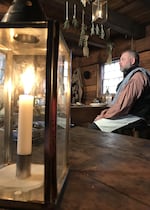At one time in history, beaver fur was the object of global trade, made especially desirable because the felted skins were fashioned into men’s hats.
“— Doug Wilson, Archaeologist National Park Service, Pacific West RegionThose beaver hats were incredibly valuable. They were like having a Rolex watch today. It was a status symbol. And people would come 18,000 miles by sailing ship around the tip of South America through the Hawaiian Islands and wind up [in the Northwest] just to acquire those animal pelts.”
In the vanguard of the fur trade was a British business called the Hudson’s Bay Company. The HBC had an enormous reach, building trading posts throughout large swaths of North America. A company established by royal charter, the HBC also had a quasi-governmental role as a colonizing force on the continent.

Stormy skies over Fort Vancouver
Photo Courtesy of Beth Harrington
In the 1820s, the executives of the HBC decided to build a post on the north bank of the Columbia River near the site of present-day Vancouver, Washington.
Fort Vancouver would be the focal point of trade for what was called the Columbia Department which stretched from the Rocky Mountains to the Pacific coast, north to Sitka, Alaska and south to what would become San Francisco.
Heading up the Fort – the “Chief Factor” – was a man named Dr. John McLoughlin, who would have to contend not only with running a smooth operation for the HBC, but somehow maintaining a harmonious relationship with the tidal wave of American immigrants coming to the region on the Oregon Trail.

NPS Ranger Scott Irvine portrays the life of a Hudson's Bay Company steward in the kitchen of the Chief Factor's House at Fort Vancouver.
Photo Courtesy of Beth Harrington
In addition, the Chief Factor would preside over a multicultural community unheard of at that time. Around the Fort, HBC employees numbered in the hundreds and represented over 30 tribal groups, as well as Scots, Irish, Orkney Islanders, French Canadians, mixed-race Métis people and Hawaiians.
To communicate, a language based on a native trade jargon was utilized and eventually incorporated words from many of these cultures. "Chinook wawa" became the lingua franca of Fort Vancouver and the region.
“Fort Vancouver” tells the engaging story of this place, its people and how they shaped the Pacific Northwest.
Resources and Information
Website Resources
- Dictionary of the Chinook Trade Language
- Fort Vancouver National Historic Site – National Historic Site
- Fur Trade in Oregon Country – The Oregon Encyclopedia
- Hudson's Bay Company History Foundation
- Ke Kekui Foundation, Vancouver Washington - Native Hawaiian/Pacific Island Culture
- McLoughlin House – National Park Service
Books
- Brown, John Arthur and Rudy, Robert, Indians of the Pacific Northwest: A History, 1981
- Bruce, George, The Remarkable History of the Hudson's Bay Company, 2014
- Campbell, Maria, Contours of a People: Metis Family, Mobility, and History, 2014
- Hussey, J.A., Fort Vancouver, 1957
- Johnson, Robert C., John McLoughlin: Father of Oregon, 1958
- Mack, Lois, One Place Across Time: National Historic Reserve, Vancouver, Washington, 1999
- Morrison, Dorothy Nafus, Outpost – John McLoughlin and the Far Northwest, 1999
- Raffan, James, Emperor of the North: Sir George Simpson and the Remarkable Story of the Hudson's Bay Company, 2010
- Sampson, ed., William R., John McLoughlin's Business Correspondence, 1847-48, 1973
- Shaw, George Coombs, The Chinook Jargon and How to Use It, 2009